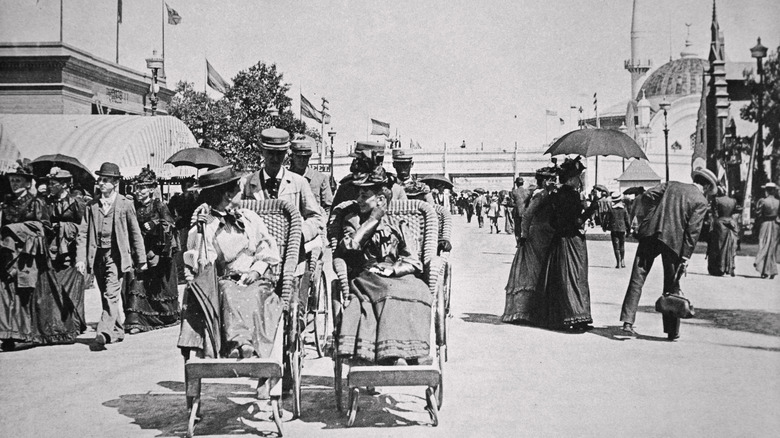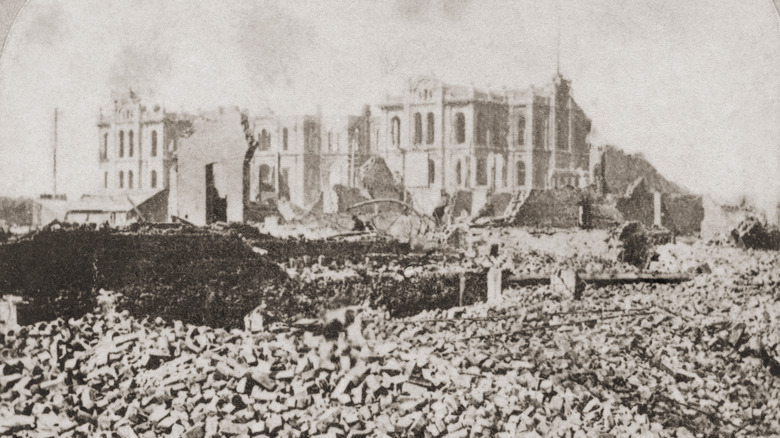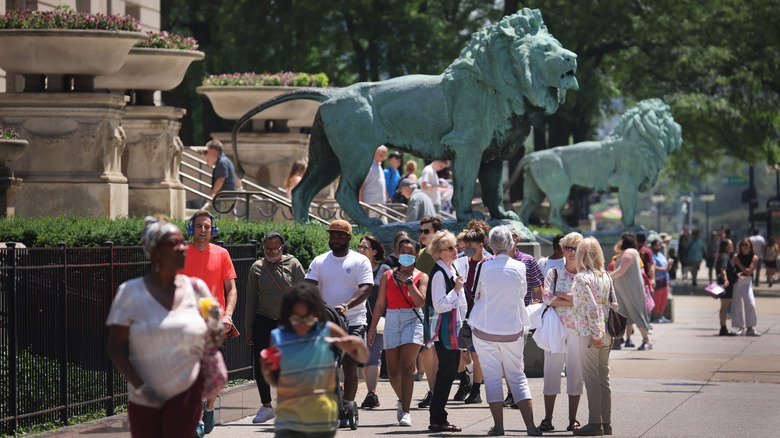The Two Fires That Devastated The 1893 World's Fair
The World's Columbian Exposition, aka Chicago's World Fair, held in 1893, celebrated the 400th anniversary of Christopher Columbus' 1492 initial voyage to the New World. The much-ballyhooed event also debuted several innovations, including the Ferris Wheel, a mechanical marvel 264 feet high that allowed visitors to see the sights from the sky; Cracker Jack Popcorn, a mix of molasses, peanuts and popcorn that still is sold today; and landscaping and architecture that inspired American design for decades.
The fair organizers hired legendary landscape architect Frederick Law Olmstead, the man behind Central Park and the U.S. Capitol grounds (per Architect of the Capitol), to develop the fair site. Olmstead created a seascape theme in Jackson Park on Lake Michigan, according to PBS' American Experience, which featured several man-made pools and canals that allowed the buildings, constructed on raised terraces, to appear like islands amid the waters. The fair also featured designs from some of the leading architects of the time, including Richard Morris Hunt (responsible for the Metropolitan Museum's façade), Charles McKim (New York Public Library) and George B. Post (The New York Times building).
The fair also offered performances to the more than 27 million who attended (according to the U.S. Census Bureau). Fair-goers could enjoy the likes of Harry Houdini's escape act, ragtime great Scott Joplin, and the Wild West Show of Buffalo Bill Cody. But all of this was threatened — not once, but twice — by fire.
Chicago's history with fire
Downtown Chicago had suffered a terrible fire in 1871, when an inferno raged through the city from October 8-10, gutting it. The blaze burned 17,500 buildings (see ruined Court House above), along 73 miles of street, according to National Geographic. One in three of all residents lost their home.
But Chi-town rallied. The co-owner of the Chicago Tribune newspaper offered inspiration in the October 11, 1871 edition, telling the public that "the people of this once beautiful city have resolved that Chicago shall rise again," reported the Chicago PBS station WTTW.
By the time of the World's Fair 22 years later, the city thrived. Still, despite the city's experience with fire, flames destroyed fair attractions twice during its six-month run.
The first occurred on July 10, 1893 in a cold storage plant, in a space used for vendors' food, according to the Chicago Tribune. The building's design trapped firefighters, and some at the tower's top chose to leap into the fire rather than wait for it to consume them. "Closer and closer together huddled the men on that narrow wooden ledge that stood between them and death," said the newspaper. "They knew that there was little chance of escape and with the courage of true heroes they resolved to meet it like brave men."
What's left of the Chicago World's Fair?
Twelve firefighters — the deadliest firefighting occurrence at the time — and four civilians perished, and an investigation charged four individuals with criminal negligence, including chief of construction Daniel Burnham, although all of them were absolved.
Another fire consumed much of the fairgrounds on January 8, 1894. The blaze began in the Casino, and burned down a gate known as the Peristyle and the Music Hall, and damaged many buildings located in the Court of Honor while 20,000 people watched, according to a Chicago Tribune article from that day.
Remnants of the fair can still be seen today. Visitors can stroll along the lake in the 600-acre Jackson Park, site of the expo, according to Choose Chicago. There sightseers can view the Garden of the Phoenix, a Japanese-inspired spot that stands on the one-time site of the Phoenix Pavilion, a World's Fair exhibit.
There's also the Museum of Science and Industry, one of only two fair buildings remaining in use in Chicago. One building, originally the Palace of Fine Arts, features a Neo-classical design. The Art Institute of Chicago was the only structure not close to or on the park, and was used as an extra site for conferences during the event. Now you can see more than 300,000 works of art at the facility.


